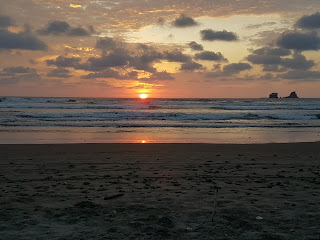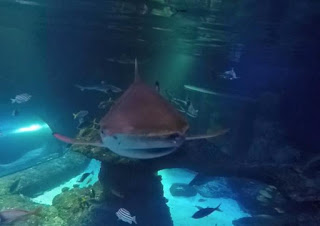Ecuador
On January 14th, 2018, I made my first research trip to Ecuador for my PhD. I had been putting this post off for a while because I couldn't find the right words to describe just how much I enjoyed this trip!
It started off with a pretty long journey from Amsterdam, stopping in Philadelphia and then Miami, finally arriving in Quito the next day. I travelled with Sarah, who is currently doing a Post Doc in our lab having just finished her PhD. Although I was quite jet lagged and groggy from the flight, my excitement persisted, taking everything in like a sponge.
We spent the first few days in Cumbayá, which was just outside of Quito close to Universidad de San Fransisco de Quito. We had the pleasure of visiting the university as well and, I was jealous. A lovely, green and spacious campus, with excellent facilities. They had a large pond in the middle of their campus! I was very excited about that.
After spending two days in Cumbaya, it was time to make the long trip down to Ayampe. We were taking part in a field trip down to the coast with American students doing an exchange course in Ecuador and the Galapagos (I know super jealous)! Margarita was the lecturer in charge, who was accompanied by her research assistant Pablo. They made this trip amazing, I couldn't thank them enough.
So we were all set to go, ready for this 11 hour bus ride. The trip itself was beautiful, starting off with a mountainous landscape surrounded by rainforests then slowly descending to a dryer and warm climate with a landscape similar to the West Coast in California, U.S.A.
This was a picture I took while passing through the Cloud forest (my picture does not do it any justice. it was beautiful).
The first place we stayed was Finca Punta Ayampe, a hotel found about 200m from the beach. This beach wasn't very busy. It only got busy at 4pm when surfers took on the waves. If you ever get a chance to go to Ayampe, this is where you need to stay! The hosts are super friendly, the food is delicious and it's just a wonderful hotel.
It started off with a pretty long journey from Amsterdam, stopping in Philadelphia and then Miami, finally arriving in Quito the next day. I travelled with Sarah, who is currently doing a Post Doc in our lab having just finished her PhD. Although I was quite jet lagged and groggy from the flight, my excitement persisted, taking everything in like a sponge.
We spent the first few days in Cumbayá, which was just outside of Quito close to Universidad de San Fransisco de Quito. We had the pleasure of visiting the university as well and, I was jealous. A lovely, green and spacious campus, with excellent facilities. They had a large pond in the middle of their campus! I was very excited about that.
After spending two days in Cumbaya, it was time to make the long trip down to Ayampe. We were taking part in a field trip down to the coast with American students doing an exchange course in Ecuador and the Galapagos (I know super jealous)! Margarita was the lecturer in charge, who was accompanied by her research assistant Pablo. They made this trip amazing, I couldn't thank them enough.
So we were all set to go, ready for this 11 hour bus ride. The trip itself was beautiful, starting off with a mountainous landscape surrounded by rainforests then slowly descending to a dryer and warm climate with a landscape similar to the West Coast in California, U.S.A.
This was a picture I took while passing through the Cloud forest (my picture does not do it any justice. it was beautiful).
When you first get a glimpse of the coast, it's breathtaking. It was starting to get hot, about 30 degrees, possibly more at the time. Basically paradise. I didn't think it could get any better than that, but Ecuador had so much more to offer!
The first place we stayed was Finca Punta Ayampe, a hotel found about 200m from the beach. This beach wasn't very busy. It only got busy at 4pm when surfers took on the waves. If you ever get a chance to go to Ayampe, this is where you need to stay! The hosts are super friendly, the food is delicious and it's just a wonderful hotel.
This was the view from our room. Waking up to this every morning definitely kept us motivated.
Just me being silly in a hammock (they were everywhere). Really comfortable but hard to get out of.
Being on the West coast meant that every night you could see the sun setting on the horizon. I liked to spend my evenings doing some work on the beach whilst watching the sunset. I often got accompanied by a random dog on the beach who would come and admire the view with me.
We accompanied the students every day when they went to do their intertidal work. They did this at La Playita, La Rinconada, Machililla and Estero del Plátano. Unfortunately, even in quite remote places like this, we saw plastic pollution lining the sandy beaches.
But, there were also views like this from the intertidal zones.
So you're probably wondering when I am going to start doing some work...My task for this trip was to meet with collaborators and make new contacts in Ecuador so that I could start my research there and, also get an idea of how the fish markets work. What I learnt from this trip was that you really need know the area you want to carry out your research in before you jump in and do anything. It can be overwhelming if you don't plan enough in advance. The fish markets were completely different to how I imagined them and, if I had gone in straight away without visiting Ecuador first, I would've really struggled. Another thing I learnt was that when I was relaxed (like I was here), I got so much more work done. I felt like the ideas just kept coming.
Fishing is one of Ecuadors main sources of income, providing jobs for over 57,000 fishers! Sadly though, thousands of sharks get caught as by-catch each year in Ecuador posing a significant threat on future shark populations in the Eastern Pacific. The first fish market we visited was in Puerto López in Manabí. It was situated on a small beach, with hundreds of fishing boats coming in and landing their catch. This market was pretty hectic, hundreds of fisherman surrounded the shore, with fish being taken straight from the boats on the beach to the trucks or to the little stalls that made up the market. I had never seen anything like this in my life. We had to wake up early to witness this event, so we headed there at around 4:45am. This, of course, was quite a struggle but it was worth the early morning to witness the incredible work these fisherman do every day. It was an eye opener for me as well because I realised just how hard my job was going to be working with sharks from this market.
The second market we visited was Santa Rosa in Salinas, Santa Elena. This market was completely different to Puerto López. It was more like a landing area where fishers came and dropped off their catch. We saw a lot more here than we did in Puerto López, including more sharks. We stood in amazement as these men carried heavy loads of fish and watched as one man single handily chopped up huge fish like swordfish with one machete. This was definitely going to be a key market for my research.
We stayed at Muyoyo lodge in Ayangue for two nights. This was another amazing location, situated close to the coast (we could walk to see the cliffs there- picture below). https://www.muyuyolodge.com/home/
The last market we visited was Esmeraldas, which was even bigger than the first two and much more organised. It was a giant landing port with tiny stalls running along the dock. Each stall had a few fisherman sitting outside and a bunch of freezers in the stall itself. And again we saw sharks being landed, but mostly dolphin fish as this was the dolphin fish season.
The last place we stayed at was Playa Escondita, an eco lodge. This lodge had it's own little beach and forest. It was beautiful. I got to witness my first iguana in a tree which was possibly one of the craziest things I had ever seen in my life. This lodge was in Esmeraldas which had a different climate to Santa Elena and Manabí. Esmeraldas was hot and humid. The difference was clear in the way that we were suddenly surrounded by a very colourful and green landscape, with much more diversity than the dry habitat we found in the other two provinces.
On the left was the view from our little hut in the eco lodge and on the right was the main part of the eco lodge which was situated right on the beach.
Sarah and I just hanging out, doing work in a hammock...
During this trip we got to experience Ecuadors amazing cuisine! It consisted of a lot of rice, patagones (fried plantain), lentils, hot sauce and 'mahi mahi' (sustainable dolphin fish).
It was absolutely delicious. Usually juice was served with every meal as well. I was obsessed with maracuyá (passion fruit) juice; it was sweet and sour at the same time. There were so many different types of fruit in Ecuador and, although it wasn't mango season, I still had some (and it was the best thing). Fruit trees were everywhere, as if it was a normal thing... which is hard to imagine in rainy and cold Manchester. One juice I could not get behind though was the tree tomato juice. I love tomato juice, but this was nothing like it. The same goes for their papaya juice, this fruit has quite an unusual taste anyway but when made into juice it's just... weird. Stick to the passion fruit juice.
Overall, this trip was one of the best two weeks of my life! The students that came with us were so friendly as well, and I couldn't have asked for better company. And I really couldn't have done it without Sarah who kept me motivated the whole time and was the best travel buddy I could've asked for! The next trip I make to Ecuador will be to collect samples. This was just a small taste of what is yet to come; the first of many exciting adventures!





























Comments
Post a Comment